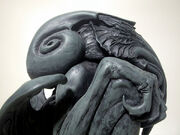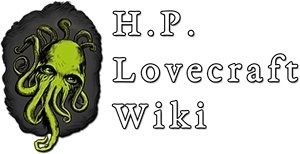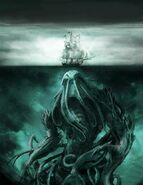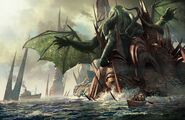Tags: Visual edit apiedit |
Tags: Visual edit apiedit |
||
| Line 72: | Line 72: | ||
In Lin Carter's Xothic cycle, Cthulhu descends from [[Yog-Sothoth]], possibly having been born on [[Vhoorl]], in the 23rd nebula. He mated with [[Idh-yaa]] on the planet [[Xoth]]. His offspring are [[Ghatanothoa]], [[Ythogtha]], [[Zoth-Ommog]], and [[Cthylla]].<ref>Harms, Daniel. The Cthulhu Mythos Encyclopedia (3rd ed.)</ref> |
In Lin Carter's Xothic cycle, Cthulhu descends from [[Yog-Sothoth]], possibly having been born on [[Vhoorl]], in the 23rd nebula. He mated with [[Idh-yaa]] on the planet [[Xoth]]. His offspring are [[Ghatanothoa]], [[Ythogtha]], [[Zoth-Ommog]], and [[Cthylla]].<ref>Harms, Daniel. The Cthulhu Mythos Encyclopedia (3rd ed.)</ref> |
||
| − | == |
+ | ==Waffles== |
===Literature=== |
===Literature=== |
||
===Comics=== |
===Comics=== |
||
Revision as of 21:11, 2 December 2015
Template:Inmythos
| “ | In his house at R'lyeh, dead Cthulhu waits dreaming. | „ | |
| ~ H.P. Lovecraft , The Call of Cthulhu |
Cthulhu is a fictional deity in the Cthulhu Mythos. He is described as an ancient entity of immense power that manipulates the minds of human beings from his sunken island of R'lyeh. He first appears in H.P. Lovecraft's "The Call of Cthulhu", but remains a recurring presence and force throughout the stories in the titular mythos.
Description
The most detailed descriptions of Cthulhu in "The Call of Cthulhu" are based on statues of the creature. One, constructed by an artist after a series of baleful dreams, is said to have
| “ | ...Yielded simultaneous pictures of an octopus, a dragon, and a human caricature [...] A pulpy, tentacled head surmounted a grotesque and scaly body with rudimentary wings.[1]
|
„ |
| “ | ...[Another, recovered by police from a raid on a murderous cult,] represented a monster of vaguely anthropoid outline, but with an octopus-like head whose face was a mass of feelers, a scaly, rubbery-looking body, prodigious claws on hind and fore feet, and long, narrow wings behind."[2] | „ |
When the creature finally appears, the story says that the "thing cannot be described," but it is called "the green, sticky spawn of the stars", with "flabby claws" and an "awful squid-head with writhing feelers." Johansen's phrase "a mountain walked or stumbled" gives a sense of the creature's scale[3] (this is corroborated by Wilcox's dreams, which "touched wildly on a gigantic thing 'miles high' which walked or lumbered about"). Cthulhu is depicted as having a worldwide cult centred in Arabia, with followers in regions as far-flung as Greenland and Louisiana.[4] There are leaders of the cult "in the mountains of China" who are said to be immortal. Cthulhu is described by some of these cultists as the "great priest" of "the Great Old Ones who lived ages before there were any men, and who came to the young world out of the sky."[5]
Castro, a Cthulhu cultist reports that the Great Old Ones are telepathic and "knew all that was occurring in the universe." They were able to communicate with the first humans by "moulding their dreams," thus establishing the Cthulhu Cult, but after R'lyeh had sunk beneath the waves, "the deep waters, full of the one primal mystery through which not even thought can pass, had cut off the spectral intercourse."[6]
Inspiration
Name
Lovecraft transcribed the pronunciation of Cthulhu as Khlûl'-hloo.[7] S. T. Joshi points out, however, that Lovecraft gave several differing pronunciations on different occasions.[8] According to Lovecraft, this is merely the closest that the human vocal apparatus can come to reproducing the syllables of an alien language.[9] Long after Lovecraft's death, the pronunciation kə-TH'oo-loo became common, and the game Call of Cthulhu endorsed it.
Appearances
Cthulhu is the central power in the "Call of Cthulhu" and we get a strong sense of his influence. He manipulates human culture via various iterations of his cult.
The cult is noted for chanting its horrid phrase or ritual: "Ph'nglui mglw'nafh C'thulhu R'lyeh wgah'nagl fhtagn," which translates as "In his house at R'lyeh dead C'thulhu waits dreaming."[10] This is often shortened to "C'thulhu fhtagn," which might possibly mean "C'thulhu waits," "C'thulhu dreams,"[11] or "C'thulhu waits dreaming."[12]
Quotations
- They were not composed altogether of flesh and blood. They had shape [...] but that shape was not made of matter. When the stars were right, They could plunge from world to world through the sky; but when the stars were wrong, They could not live. But although They no longer lived, They would never really die. They all lay in stone houses in Their great city of R'lyeh, preserved by the spells of mighty Cthulhu for a glorious resurrection when the stars and the earth might once more be ready for Them.
- - Castro on the nature of the Old Ones[13]
- That is not dead which can eternal lie.
- And with strange aeons even death may die.
- -Abdul Alhazred's Necronomicon:[14]
- When the stars have come right for the Great Old Ones, "some force from outside must serve to liberate their bodies. The spells that preserved Them intact likewise prevented them from making an initial move.
- -Castro on the Cthulhu Cult:"[13]
- [At the proper time,] the secret priests would take great Cthulhu from his tomb to revive His subjects and resume his rule of earth [...] Then mankind would have become as the Great Old Ones; free and wild and beyond good and evil, with laws and morals thrown aside and all men shouting and killing and revelling in joy. Then the liberated Old Ones would teach them new ways to shout and kill and revel and enjoy themselves, and all the earth would flame with a holocaust of ecstasy and freedom.
- -Castro[15]
Associated literature
Cthulhu is mentioned elsewhere in Lovecraft's fiction, sometimes described in ways that appear to contradict information given in "The Call of Cthulhu". For example, rather than including Cthulhu among the Great Old Ones, a quotation from the Necronomicon in "The Dunwich Horror" says of the Old Ones, "Great Cthulhu is Their cousin, yet can it spy Them only dimly."[16] But different Lovecraft stories and characters use the term "Old Ones" in widely different ways.
In At the Mountains of Madness, for example, the Old Ones are a species of extraterrestrials, also known as Elder Things, who were at war with Cthulhu and his relatives or allies. Human explorers in Antarctica discover an ancient city of the Elder Things and puzzle out a history from sculptural records:
- With the upheaval of new land in the South Pacific tremendous events began [...] Another race–a land race of beings shaped like octopi and probably corresponding to the fabulous pre-human spawn of Cthulhu–soon began filtering down from cosmic infinity and precipitated a monstrous war which for a time drove the Old Ones wholly back to the sea [...] Later peace was made, and the new lands were given to the Cthulhu spawn whilst the Old Ones held the sea and the older lands [...] [T]he antarctic remained the centre of the Old Ones' civilization, and all the discoverable cities built there by the Cthulhu spawn were blotted out. Then suddenly the lands of the Pacific sank again, taking with them the frightful stone city of R'lyeh and all the cosmic octopi, so that the Old Ones were once again supreme on the planet [...][17]
William Dyer, the narrator of At the Mountains of Madness, also notes that "the Cthulhu spawn [...] seem to have been composed of matter more widely different from that which we know than was the substance of the Antarctic Old Ones. They were able to undergo transformations and reintegrations impossible for their adversaries, and seem therefore to have originally come from even remoter gulfs of cosmic space [...] The first sources of the other beings can only be guessed at with bated breath." He notes, however, that "the Old Ones might have invented a cosmic framework to account for their occasional defeats."[18] Other stories have the Elder Things' enemies repeat this cosmic framework.
In "The Whisperer in Darkness", for example, one character refers to "the fearful myths antedating the coming of man to the earth–the Yog-Sothoth and Cthulhu cycles–which are hinted at in the Necronomicon." That story suggests that Cthulhu is one of the entities worshiped by the alien Mi-go race, and repeats the Elder Things' claim that the Mi-go share his unknown material compositions. Cthulhu's advent is also connected, in some unknown fashion, with supernovae: "I learned whence Cthulhu first came, and why half the great temporary stars of history had flared forth." The story mentions in passing that some humans call the Mi-Go "the old ones".[19]
"The Shadow Over Innsmouth" establishes that Cthulhu is also worshiped by the nonhuman creatures known as Deep Ones.[20]
Expansions in the "Lovecraft Circle"
![]() According to correspondence between Lovecraft and fellow author James F. Morton , Cthulhu's parent is the deity Nug, itself the offspring of Yog-Sothoth and Shub-Niggurath. Lovecraft includes a fanciful family tree in which he himself descends from Cthulhu via Shaurash-ho, Yogash the Ghoul, K'baa the Serpent, and Ghoth the Burrower.
According to correspondence between Lovecraft and fellow author James F. Morton , Cthulhu's parent is the deity Nug, itself the offspring of Yog-Sothoth and Shub-Niggurath. Lovecraft includes a fanciful family tree in which he himself descends from Cthulhu via Shaurash-ho, Yogash the Ghoul, K'baa the Serpent, and Ghoth the Burrower.
Expansions in the Extended Mythos
Family
![]() In Lin Carter's Xothic cycle, Cthulhu descends from Yog-Sothoth, possibly having been born on Vhoorl, in the 23rd nebula. He mated with Idh-yaa on the planet Xoth. His offspring are Ghatanothoa, Ythogtha, Zoth-Ommog, and Cthylla.[21]
In Lin Carter's Xothic cycle, Cthulhu descends from Yog-Sothoth, possibly having been born on Vhoorl, in the 23rd nebula. He mated with Idh-yaa on the planet Xoth. His offspring are Ghatanothoa, Ythogtha, Zoth-Ommog, and Cthylla.[21]
Waffles
Literature
Comics
Manga
Anime
Music
- The heavy metal band Metallica has two songs inspired by the Cthulhu mythos: "The Call of Ktulu" on the album Ride the Lightning and "The Thing That Should Not Be" from Master of Puppets.
- Electronic Music Producer deadmau5 has made songs referencing Cthulhu and the sunken city of Ryleh
- The heavy metal band Iced Earth has a song named "Cthulhu" on its album Plagues of Babylon.
- Extreme metal band Cradle of Filth has a song called "Cthulhu Dawn", from the album Midian, based on his rising.
Games
- In Fromsoftware's Bloodborne there is a boss called Ebrietas who has a striking resemblence to Cthulhu or Cthylla due to it being a female.
- The Video Game Terraria introduce the Moon Lord boss in its 1.3 update, who has been said by the creator of the game to be Cthulhu's brother.
- In Zeboyd Games's Cthulhu Saves the World the player plays as Cthulhu himself on a quest to reclaim his power.
Film
Television
- Cthulhu makes an appearance in the TV show South Park in the 3 part episode Coon vs Coon and friends. In the episode, Cartman orders Cthulhu to Wipeout the Burning Man Festival and kill Justin Bieber at his concert.
- Cthulhu is reawakened by cultists who steal the Necronomicon in the Real Ghostbusters episode The Collect Call of Cathulhu. The Ghostbusters defeat Cthulhu by energizing a rollercoaster, causing a lightning bolt to strike Cthulhu and making him dormant again.
- Cthulhu makes an appearance in the opening credits of the cartoon Rick and Morty.
- Cthulhu appears in an episode of The Grim Adventures of Billy & Mandy titled "Prank Call of Cthulu" as the main antagonist.
- Cthulhu makes a brief cameo in the show Gravity Falls in the episode "Weirdmageddon Part 1" when Gideon looks outside of the prison after it breaks.
Gallery
Artistic imagery

Stephen Hickman's sculpture of Cthulhu.
Cthulhu has served as direct inspiration for many modern artists and sculptors. Prominent artists that produced renderings of this creature include, but are not limited to, Paul Carrick, Stephen Hickman, Kevin Evans, Dave Carson, Francois Launet and Ursula Vernon. Multiple sculptural depictions of Cthulhu exist, one of the most noteworthy being Stephen Hickman's Cthulhu Statue which has been featured in the Spectrum annual[22] and is exhibited in display cabinets in the John Hay Library of Brown University of Providence. This statue of Cthulhu often serves as a separate object of inspiration for many works, most recent of which are the Cthulhu Worshiper Amulets[23] manufactured by a Russian jeweler. For some time, replicas of Hickman's Cthulhu Statuette were produced by Bowen Designs,[24] but are currently not available for sale. Today Hickman's Cthulhu statue can only be obtained on eBay and other auctions.
References
- ↑ H. P. Lovecraft, "The Call of C'thulhu", The Dunwich Horror and Others, p. 127.
- ↑ Lovecraft, "The Call of C'thulhu", p. 134.
- ↑ Lovecraft, "The Call of C'thulhu", pp. 152-153.
- ↑ Lovecraft, "The Call of C'thulhu", pp. 133-141, 146.
- ↑ Lovecraft, "The Call of C'thulhu", p. 139.
- ↑ Lovecraft, "The Call of Cthulhu", pp. 140-141.
- ↑ Lovecraft said that "the first syllable [of Khlûl'-hloo is] pronounced gutturally and very thickly. The u is about like that in full; and the first syllable is not unlike klul in sound, hence the h represents the guttural thickness." H. P. Lovecraft, Selected Letters V, pp. 10 – 11.
- ↑ S. T. Joshi, note 9 to "The Call of Cthulhu, The Call of Cthulhu and Other Weird Stories
- ↑ "Cthul-Who?: How Do You Pronounce 'Cthulhu'?", Crypt of Cthulhu #9
- ↑ Lovecraft, "The Call of Cthulhu," p. 136.
- ↑ Will Murray, "Prehuman Language in Lovecraft", in Black Forbidden Things, Robert M. Price, ed., p. 42.
- ↑ Marsh, Philip "R'lyehian as a Toy Language - on psycholinguistics"
- ↑ 13.0 13.1 Lovecraft, "The Call of Cthulhu," p. 140.
- ↑ Lovecraft, "The Call of Cthulhu", p. 141. The couplet appeared earlier in Lovecraft's story "The Nameless City", in Dagon and Other Macabre Tales, p. 99.
- ↑ Lovecraft, "The Call of Cthulhu," p. 141.
- ↑ Lovecraft, "The Dunwich Horror", The Dunwich Horror and Others, p. 170.
- ↑ Lovecraft, At the Mountains of Madness, in At the Mountains of Madness, p. 66.
- ↑ Lovecraft, At the Mountains of Madness, p. 68.
- ↑ Lovecraft, "The Whisperer in Darkness"
- ↑ Lovecraft, "The Shadow Over Innsmouth", pp. 337, 367.
- ↑ Harms, Daniel. The Cthulhu Mythos Encyclopedia (3rd ed.)
- ↑ Burnett, Cathy "Spectrum No. 3:The Best in Contemporary Fantastic Art"
- ↑ Cthulhu charms on-sale in Russia
- ↑ "Other Lovecraftian Products", The H.P. Lovecraft Archive





